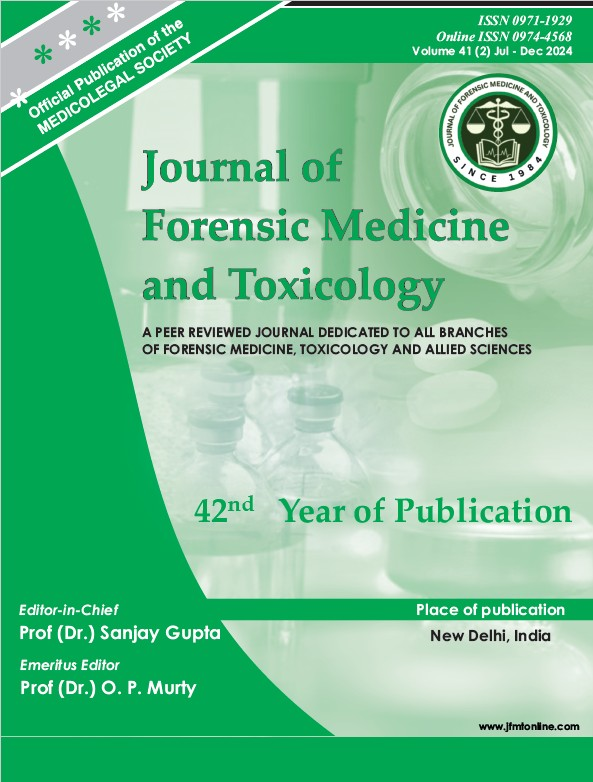SNAKE BITE FATALITY- HISTOPATHOLOGY OF VARIOUS ORGANS
DOI:
https://doi.org/10.48165/jfmt.2024.41.1.29Keywords:
Snake bite, Cause of death, Histopathology, AutopsyAbstract
There are 3500 species of snakes, of which 250 are venomous. In India about 216 species, of which 52 are poisonous. World Health Organization records more than 2.5 million venomous snake bites worldwide each year with more than125000 deaths. India records about 2,00,000 bites of which 15000 end in deaths. Snake venoms can be classified as hemotoxic, neurotoxic, or cytotoxic and they can all act together involving multiple tissues and organs. Mortality due to poisonous snakebite is an emerging public health concern. In India snakebite deaths are unnatural deaths. So, they are medicolegal cases that need to be examined at autopsy according to statutory rules. In many cases history of bite might not always be consistent. Internal findings at autopsy in fatal snakebite cases are often non-specific. Suspicious and unknown bites are also difficult to diagnose and establish at autopsy. Snakebite induced changes in various organs are documented in literature. Some authors have tried to develop a scoring system on the basis of the renal pathology found at autopsy in fatal snakebite cases to differentiate between neurotoxic and haemotoxic bites. Histological changes in the organs that are primary targets by the snake venom may help and guide the pathologist and physician in their early intervention. Here, we present post-mortem histopathological findings of 2 cases of snake bite.
Downloads
References
KSN Reddy. Organic irritant poisons, snakes. The essentials of Forensic Medicine & Toxicology. 34rth edition 2020. Medical book company. Hyderabad. Pg.510.
V.V. Pillay. Venomous bites and stings. Modern medical toxicology. 4th Edition. published by Jaypee brothers, New Delhi. 2013. Pg. 146-150.
Partha Pratim Mukhopadhyay, Sulekha Ghosh et al. Forensic diagnosis and classification of snakebite (neurotoxic and haemotoxic) from renal changes at autopsy: morphological and histological determinants using a semi-quantitative method. Med Sci Law. 2010; 50: 140–144. DOI: 10.1258/msl.2010.010090.
Dayanira Paniagua, Kendall Crowns et al. Postmortem histopathology and detection of venom by ELISA following suicide by cobra (Naja kaouthia) envenomation. Forensic Toxicology. 2020; 38: 523-528.
Alessandro Feola, Gian Luca Marella et al. Snakebite Envenoming a Challenging Diagnosis for the Forensic Pathologist: A Systematic Review. Toxins. 2020; 12, 699: 2-19.
K Sathish, Kusa Kumar Saha et al. Histopathological profile of fatal snake bite autopsy cases in a tertiary care center in South India. Egyptian Journal of Forensic Sciences. 2021; 11:3: 1-8.
L.A. Benvenuti, Francisco OS Franca et al. Pulmonary haemorrhage causing rapid death after Bothrops jararacussu snakebite: a case report. Toxicon. 2003. 42: 331–334.
Blumenthal et al. Black Mamba Death Venom Versus Antivenom? Am J Forensic Med Pathol. 2019. Volume 40(4): 356-360.
Jacob Joseph Moar, Lawrence Hill. Histopatholological Findings in a Fatal Case of Rinkhals Envenomation A New Forensic Pathology Finding? Am J Forensic Med Pathol. 2016. Vol.37 (4): 236-240.
C.R. Tilbury, J. Verster. A fatal bite from the burrowing asp Atractaspis corpulenta (Hallowell 1854). Toxicon. 2016. 118: 21-26.
Naren Sarkar, Souvik Basu et al. Nephrotoxicity in krait bite: a rare case series of three fatalities in consecutive bites by a single snake. Egyptian Journal of Forensic Sciences. 2018. 8(12): 1-4.




